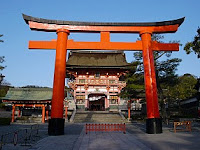Festivals
There are countless local festivals (matsuri) in Japan because almost every shrine celebrates one of its own. Most festivals are held annually and celebrate the shrine's deity or a seasonal or historical event. Some festival are held over several days.
[Read more]
Temples
Temples are the places of worship in Japanese Buddhism. Virtually every Japanese municipality has at least one temple, while large cultural centers like Kyoto have several thousands. Temples store and display sacred Buddhist objects. Some temples used to be monasteries, and some....[Read more]
Castles
The need for castles arouse after the central government's authority had weakened in the 15th century and Japan had fallen into the chaotic era of warring states (sengoku jidai). During that era, Japan consisted of dozens of small independent states which were fighting each other and, for defense purposes, were building small castles on top of mountains.
[Read more]
Shrines
Shinto shrines are places of worship and the dwellings of the kami, the Shinto "gods". Sacred objects of worship that represent the kami are stored in the innermost chamber of the shrine where they cannot be seen by anybody.
[Read more]
Historic Towns
While many of Japan's historic buildings and districts have been lost in fires, wars and due to city redevelopment, some cities and towns have managed to preserve a street block or whole district of traditional buildings.
[Read more]
Cherry Blossom (Sakura)
The cherry blossom (sakura) is Japan's unofficial national flower. It has been celebrated for many centuries and holds a very prominent position in Japanese culture.
There are many dozens of different cherry tree varieties in Japan, most of which bloom for just a couple of days in spring. The Japanese celebrate that time of the year with hanami (cherry blossom viewing) parties under the blooming trees.
[Read more]









No comments:
Post a Comment